MARIANI’SVirtual
Gourmet
October 21,
2012
NEWSLETTER
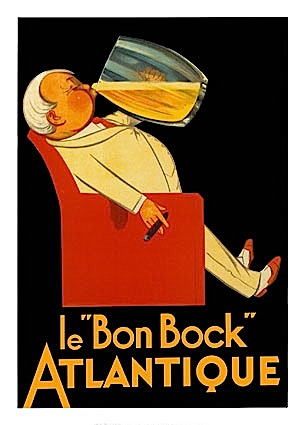
❖❖❖
ANNOUNCEMENT
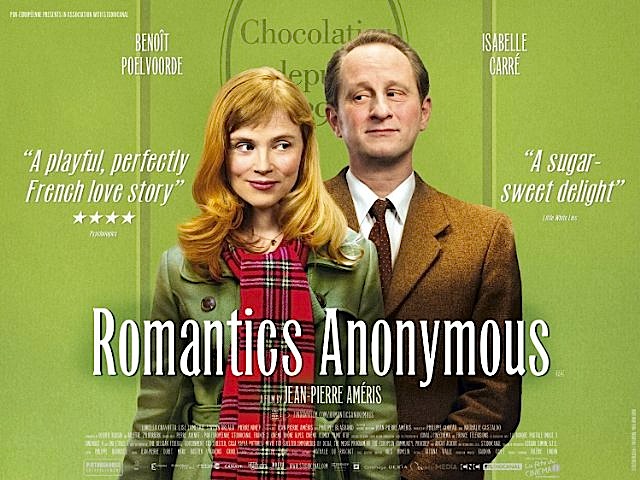
For the next two Tuesdays, in NYC, the French Institute Alliance Française, John Mariani, and special culinary guests will be hosting films (with English subtitles) that celebrate the importance of food and wine in French culture. The series is as follows: Oct. 23: "Romantics Anonymous" (2010) with a chocolate tasting with Lauren Gerbaud (at 5:30 PM); Oct. 30: "Entre les Bras" (2010) with guest host chef Jean-Louis Gérin. All screenings will be held at at Florence Gould Hall, 55 East 59th Street at 7:30 PM, followed by Q&A with host. Tickets $10. For info click here.
❖❖❖
THIS WEEK
PHILLY'S
NEW FOOD
by John Mariani
NEW YORK CORNER
BOBO
by John
Mariani
NOTES FROM THE WINE CELLAR
So You Wanna Run a Wine Tasting?
by John Mariani
❖❖❖
PHILLY'S
NEW FOOD
by John Mariani
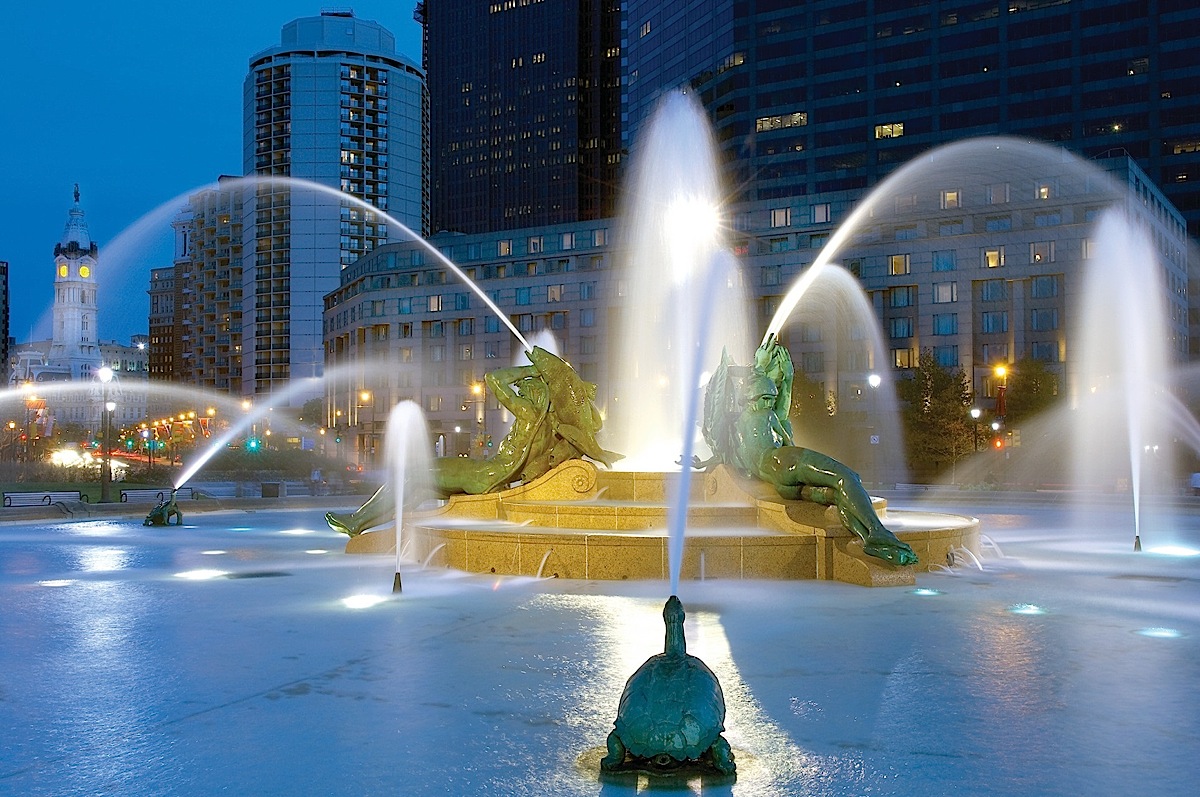
The Swann Fountain
At a time when a few
media-fueled American cooks believe their customers’
discomfort is a way of “challenging” them, Kevin
Sbraga (below)
is a chef who regards his clientele as guests who
deserve a genial respect for choosing to dine at his
place. You are greeted warmly in the kind of homey
place of which Mitt Romney might say, “The ceilings are
the right height.” You are then served a four-course
dinner you won’t soon forget, and at a
remarkable price--$49. (It was one of my top 20
New Restaurants for 2012 in Esquire
this month.)
The 60-seat dining room is bright
and cheery, with tablecloths that reflect light, and
a wonderful contrast of slatted old wood and shiny
new stainless steel, all in cool colors.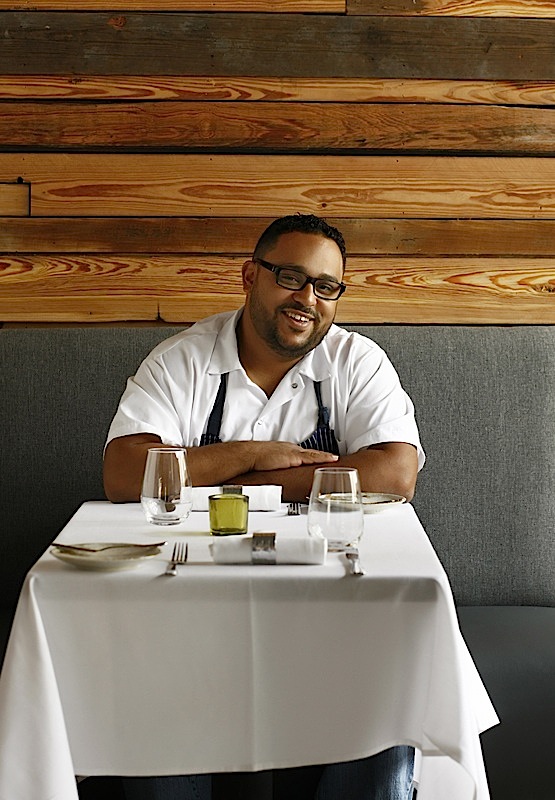
Sbraga
keeps
the menu short, so he can concentrate on every dish
that goes out from the fire—a fine balance of sweet
and hot in cider-glazed sturgeon with bok choy, kim chee and
apple; lusty, fat lamb belly with ham, peas and
onions and a complex curry sauce; the venison-foie
gras terrine with sweet and sour eggplant has just
the right mix of gaminess, 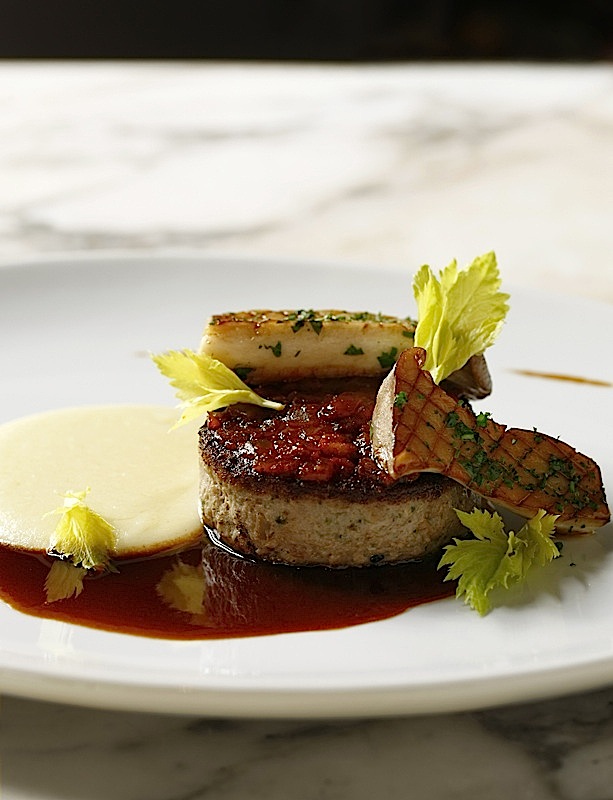 creaminess,
tart and sweet complementary flavors, and octopus
comes with a hot
piri piri sauce whose bite is tamed by a
silky tapenade. The country-fried lobster with okra,
sprouts, and onion ($16 supplement) is a revelation
of how a delicate flesh and flavor can really be
transformed by deft frying technique. Already
Sbraga's sublimated meatloaf (left), with
carrots, wild mushrooms and a hazelnut crust,
has become a signature dish, exemplary American
cooking. Like everything here, desserts are
seasonally driven; when I dined there it was time
for a strawberry-rhubarb streusel with vanilla ice
cream. Now, there's a pumpkin mousse with pecans and
pomegranates. Four splendid courses, for $49. Pretty
amazing.
creaminess,
tart and sweet complementary flavors, and octopus
comes with a hot
piri piri sauce whose bite is tamed by a
silky tapenade. The country-fried lobster with okra,
sprouts, and onion ($16 supplement) is a revelation
of how a delicate flesh and flavor can really be
transformed by deft frying technique. Already
Sbraga's sublimated meatloaf (left), with
carrots, wild mushrooms and a hazelnut crust,
has become a signature dish, exemplary American
cooking. Like everything here, desserts are
seasonally driven; when I dined there it was time
for a strawberry-rhubarb streusel with vanilla ice
cream. Now, there's a pumpkin mousse with pecans and
pomegranates. Four splendid courses, for $49. Pretty
amazing.
How does Sbraga do it? Backwards,
actually.
“Everywhere else I’ve worked, they
decided on what they wanted to serve, then set the
price,” he says. “Here we decided on the price first,
then figured out what we could offer our guests
within that range without sacrificing creativity or
quality. By
doing that and by offering smaller portions in a
pre-fixe menu, we’re able to provide guests with a
comprehensive, complete experience at a price where
we can still be successful.”
Now that's the kind of thinking
that pretty much guarantees success at a time when
so much razzle-dazzle cooking makes headlines that
fade fast.
Sbraga
is open for dinner Mon.-Sat.;Dinner $49 plus
optional $35 wine pairing.
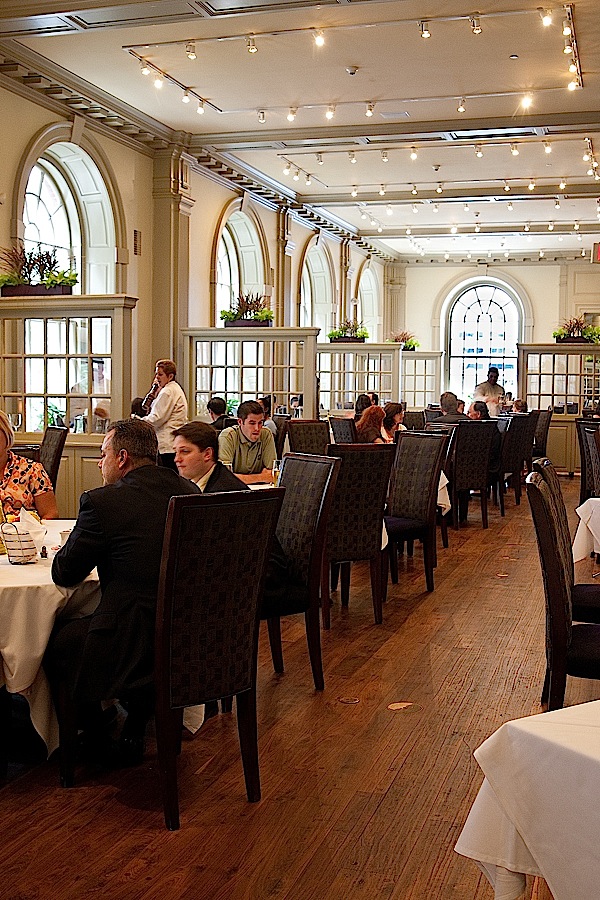
111 South 17th Street
215-563-4810
www.davios.com
Of all the chain concepts in
America, none seems to do a more consistent job
than the steakhouse genre. Maybe it's
because the rubrics of the menu were set so long
ago and because the expectations of manly
customers are high when they're willing to pay top
dollar for a piece of good beef. But the
Davio's chain, started in 1985 by Steve DiFillippo in Boston’s Back Bay,
goes a good deal further with the genre, by
offering more of the kind of Italian dishes that
are only on other chains' menus by default. There
are now Davio's locations in Foxborough, MA,
Philadelphia, and a new location in Atlanta.
The Philadelphia restaurant takes advantage
of the city’s historic cast. Set on
the second floor, the huge, long dining room
retains an intimacy by being intelligently broken
up but not closed off, and the Federalist-style
windows, columns, and tapestry upholstery give you
a sense of easy refinement, which is also part of
the modus operandi of the staff, led by manager Ettore Ceraso.
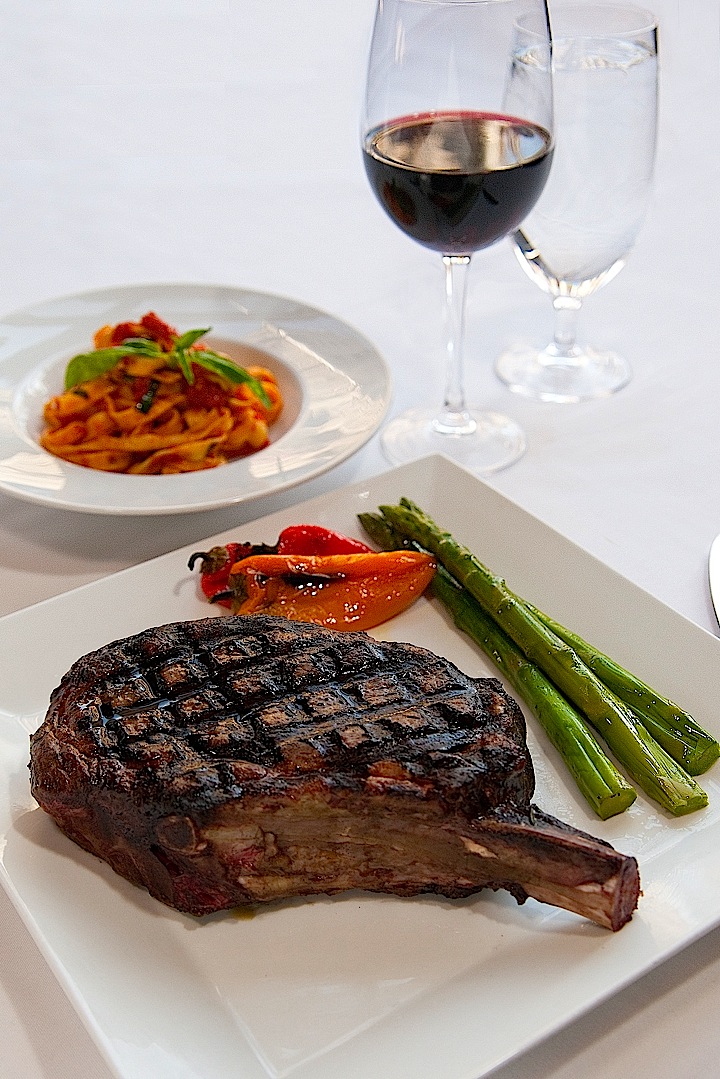 In
the
kitchen veteran chefs David Boyle and Bennett
Hollberg oversee a menu that ranges widely, from
crispy fried oysters and Hawaiian tuna tartar to a
trademarked Philly Cheese Steak Spring Roll with
homemade ketchup (they sell these packaged), from
pappardelle with jumbo crab meat and artichokes.
In
the
kitchen veteran chefs David Boyle and Bennett
Hollberg oversee a menu that ranges widely, from
crispy fried oysters and Hawaiian tuna tartar to a
trademarked Philly Cheese Steak Spring Roll with
homemade ketchup (they sell these packaged), from
pappardelle with jumbo crab meat and artichokes.
The night I was there, I
actually hosted the dinner and signed my latest
book, How
Italian Food Conquered the World, so we
had a set menu that began with silky prosciutto
with black Mission figs, olive oil, and balsamico,
followed by potato gnocchi with a braised beef
bolognese sauce of veal, beef and pork. A
massive bistecca Florentine really did have the
heft and juiciness of the Florentine original,
served with cream, Parmigiano herb polenta and a
fennel marmalade. For dessert there
was a lemoncello torta with blackberry compote
and lemoncello sorbet.
It was a sumptuous meal,
beautifully served in a style that is often in
contrast to the machismo of many steakhouses still
bound to a 1930s tradition of decor and shrugging
hospitality. Add to that Davio's extensive
menu and you have a template for what a steakhouse
in 2012 should be.
Davio's serves
breakfast and lunch Mon.-Fri., dinner nightly.
Dinner appetizers $9-$18, pastas $17-$33, main
courses $27-$51.
FOUNTAIN RESTAURANT
The Four Seasons Hotel
1 Logan Square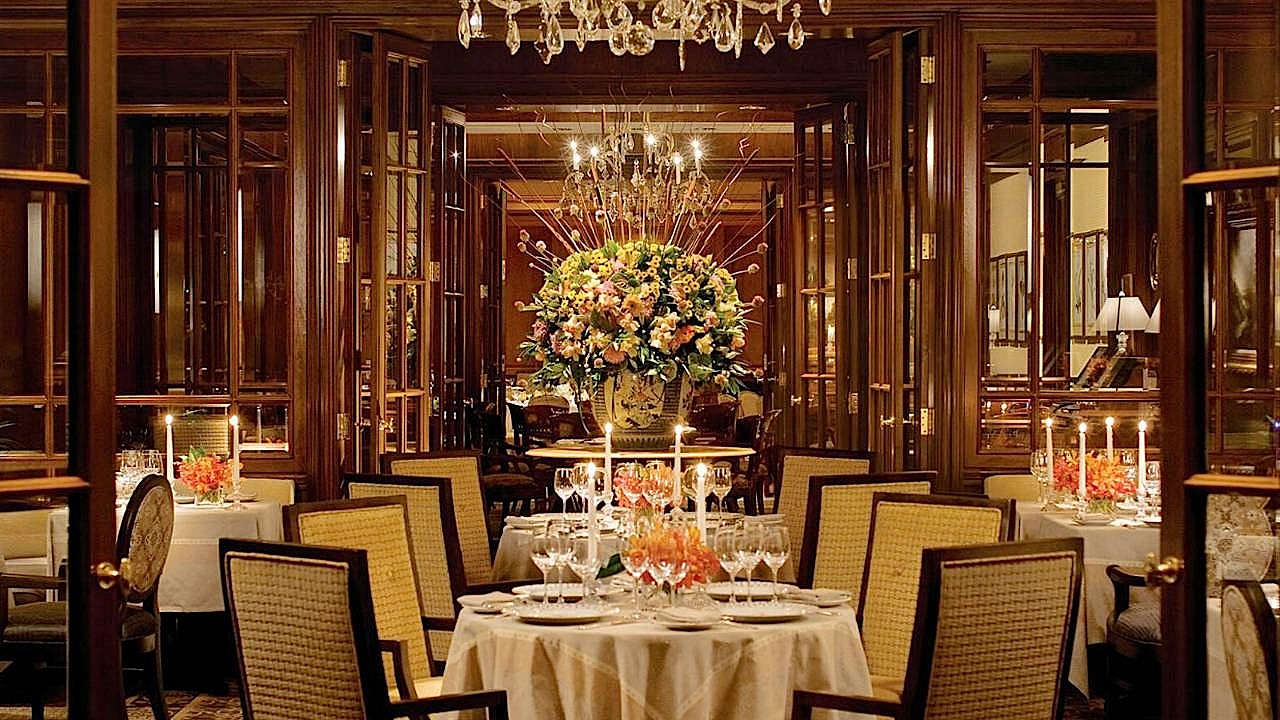
215-963-1500
www.fourseasons.com/philadelphia
For
decades
this has been the finest, most sophisticated
restaurant in the city, excellent for business
breakfast, lunch and dinner, with a superb panorama
on the beautiful Swann Fountain.
The décor has been modified over the years,
brightened and given a bit more casual appointments
(though the new servers’ outfits need rethinking),
and there have been only a few chef changes in the
last 25 years.
The new-ish guys
are exec chef Rafael Gonzalez and chef de cuisine
Peter Rosenblatt, who have cannily maintained the
haute cuisine of the menu with American swagger, and
the lunch menu, which
enjoyed recently, is full of choices,
including sandwiches and a burger rendered with the
same sophistication as the entrees in the evening.
A must-try is “Lobster
chopped” (below),
brimming with poached Maine lobster, heirloom
tomato, smoked bacon, avocado and a buttermilk
biscuit you will want
more than one of. There’s even a matzo ball soup
here, of course, made with Amish chicken. Wild rick shrimp
tempura is crisp and the right texture, with
avocado, yuzu, sriracha
rémoulade, and Truleaf purple cabbage.
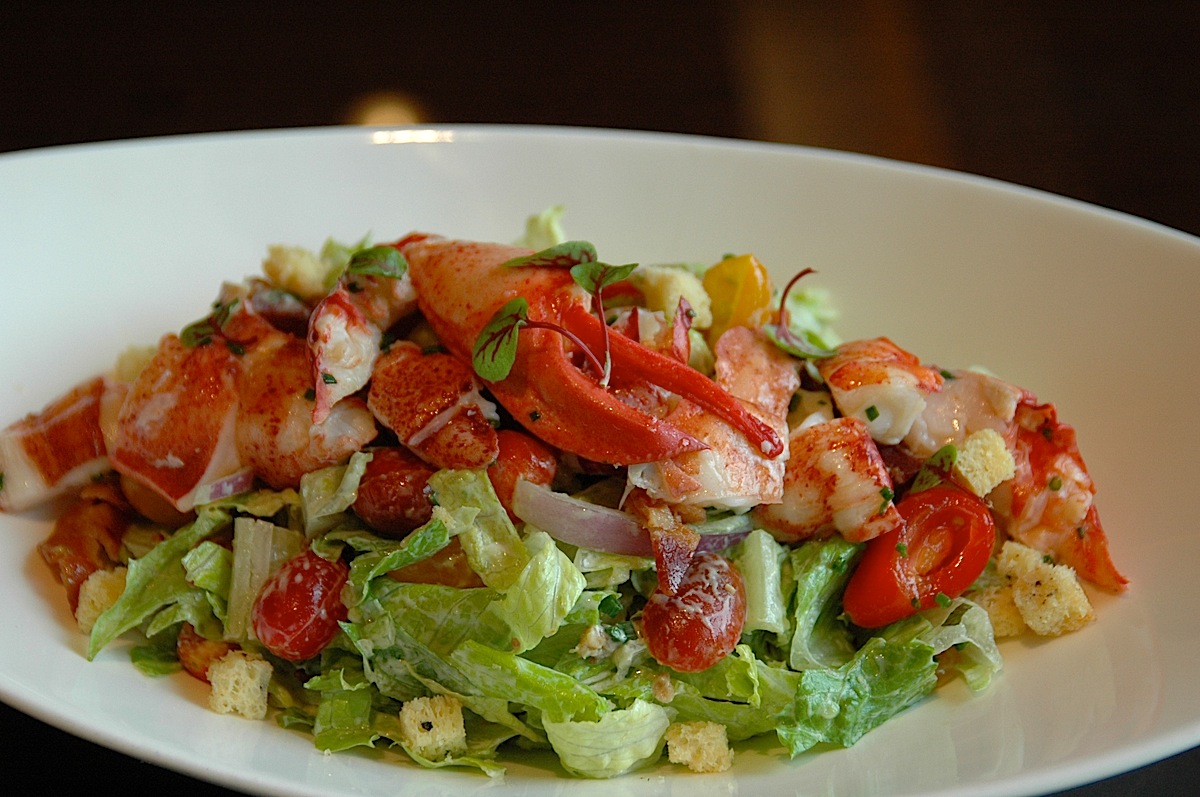 If you are just up for a salad, your
choice is well rewarded with a defining way with
good old Iceberg lettuce, crisp and cold, with
Maytag Bleu, pancetta bacon, grape tomato, sweet and
salty pinenuts, and balsamic vinegar. Another
of those Amish chickens is seared under a brick in a
hot skillet, becoming crispy and juicy, served with
Gouda-infused grits, baby spinach, buttermilk onions
and a tangy caper jus. As for that burger,
well, it’s way more than a mouthful—with truffles,
mushrooms, Sottocenere cheese, and a black truffle
aioli just to gild the lily.
If you are just up for a salad, your
choice is well rewarded with a defining way with
good old Iceberg lettuce, crisp and cold, with
Maytag Bleu, pancetta bacon, grape tomato, sweet and
salty pinenuts, and balsamic vinegar. Another
of those Amish chickens is seared under a brick in a
hot skillet, becoming crispy and juicy, served with
Gouda-infused grits, baby spinach, buttermilk onions
and a tangy caper jus. As for that burger,
well, it’s way more than a mouthful—with truffles,
mushrooms, Sottocenere cheese, and a black truffle
aioli just to gild the lily.
As
noted, the sandwiches are terrific here, including
my favorite American invention after the hamburger,
the club sandwich, here done with crispy chicken
paillard, pancetta, butter lettuce, tomato, and chive
mayo on excellent toast. It’s all in the details, as
is the case with everything at Fountain.
For dessert, don't quibble.
Soufflés are a requisite splurge at a grand
dining room like this. If you wonder about the
demise of civilized dining, look no further than
Fountain.
Fountain is open for
breakfast daily, for lunch Mon.-Sat., dinner
Tues.-Sat. Lunch appetizers $11-$26, main courses
$24-$37.
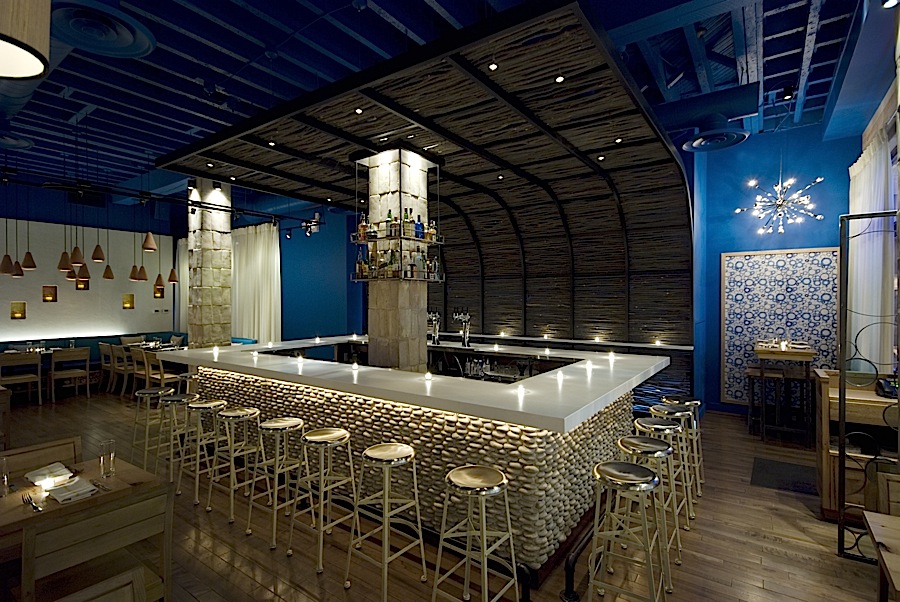 opa
opa
1311
Sansom Street
215-545-0170
www.opaphiladelphia.com
Brother
and sister George and Vasiliki Tsiouris have given
Philadelphia a first-rate and quite lovely Greek
restaurant without any pretensions, and it lives up
to its name, which is the traditional Greek
exclamation of good spirits, with they provide
within a modern setting with a wooden canopy
ceiling, a river rock bar, candlelight, oak tables,
and very comfortable banquettes, all with Aegean
blue colors throughout.
I cannot go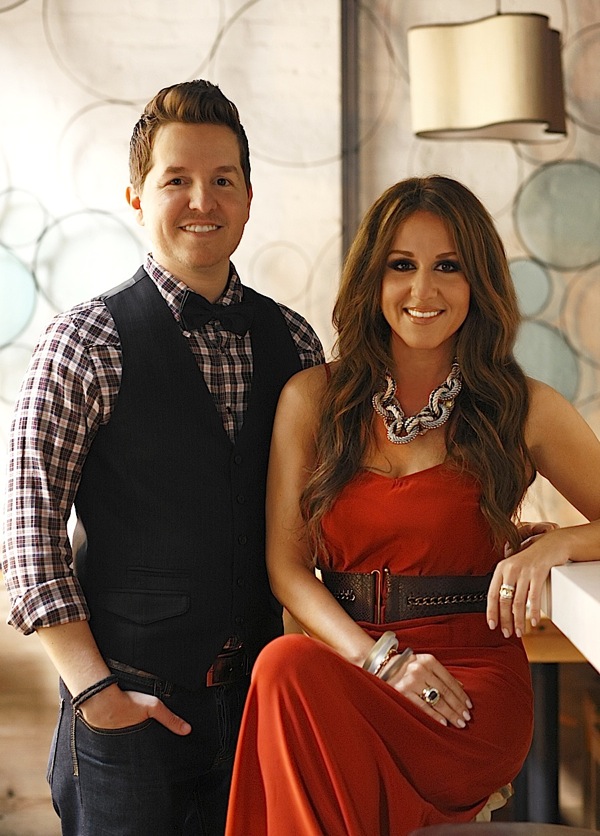 on as
enthusiastically as I'd like, because the chef has
changed since I dined at Opa, but I take the
Tsiourises (right)
at their word when they swear they are maintaining
the quality and the entire cast of the menu.
Thus, if the food is now close to what it was this
summer, I'd recommend, without elaboration, dishes
like the gyros of grilled lamb
with yogurt sauce, cucumber, onion and tomato;
cured and grilled octopus (right), with
a chickpea fondue and chili oil; pan-seared
yellowfin tuna with pickled vegetables and
shoestring potatoes; braised rabbit wit olives and
capers over pasta and shaved kefalotiri cheese;
and swordfish with potatoes, tomatoes, lemon and
green beans; and for dessert the wonderful loukoumades
beignets with honey, cinnamon, walnuts, and spiced
banana, and baklava in crispy phyllo with fig ice
cream.
on as
enthusiastically as I'd like, because the chef has
changed since I dined at Opa, but I take the
Tsiourises (right)
at their word when they swear they are maintaining
the quality and the entire cast of the menu.
Thus, if the food is now close to what it was this
summer, I'd recommend, without elaboration, dishes
like the gyros of grilled lamb
with yogurt sauce, cucumber, onion and tomato;
cured and grilled octopus (right), with
a chickpea fondue and chili oil; pan-seared
yellowfin tuna with pickled vegetables and
shoestring potatoes; braised rabbit wit olives and
capers over pasta and shaved kefalotiri cheese;
and swordfish with potatoes, tomatoes, lemon and
green beans; and for dessert the wonderful loukoumades
beignets with honey, cinnamon, walnuts, and spiced
banana, and baklava in crispy phyllo with fig ice
cream.
The wine lists has a good
selection of modern Greek bottlings at very fair
prices. as well as an array of flavored ouzos.
In the spirit of the name,
you'll have a delightful--and not expensive--time
at Opa and I feel sure you'll be well cared for by
the proud and gracious George and Vasiliki.
Opa is open
for lunch Mon.-Fri., dinner Mon.-Sat. Dinner
appetizers $8-$14, main courses $13-$17.
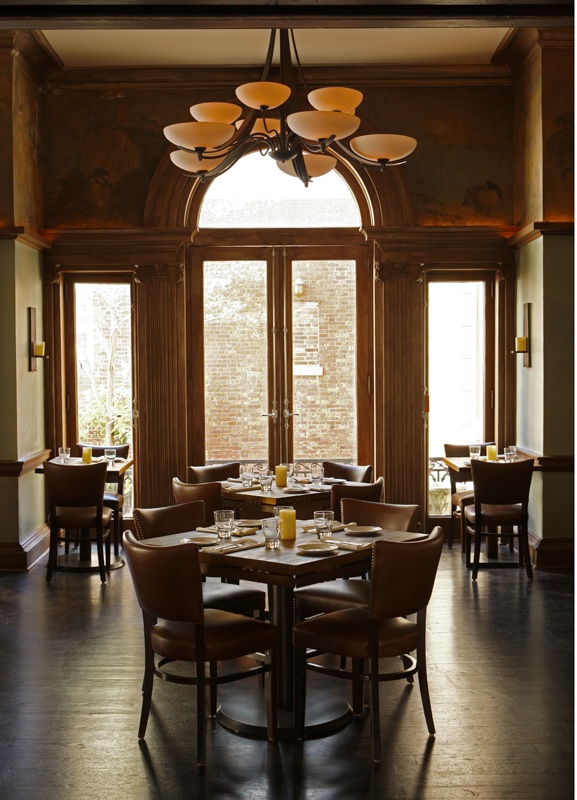 RITTENHOUSE
TAVERN
RITTENHOUSE
TAVERN
251 South 18th Street
215-732-2412
www.rittenhousetavern.com
Rittenhouse Tavern
certainly has one of the loveliest settings in
Philadelphia, inside the historic Wetherill
Mansion, one of the grand houses left on
Rittenhouse Square and now home to the Art
Alliance of Philadelphia. As such, it takes
advantage of all the decorous woodwork, lighting,
and design of the majestic structure, with
four indoor and outdoor spaces—a main dining room,
salon, bar area and cobblestoned, al fresco
garden. Do
check out the beautiful 1920s mural of geese by
Richard Blossom Farley in the main dining room.
The kitchen has impressive credentials, beginning
with local chef chef Nicholas Elmi, who
collaborates with NYC’s highly regarded Ed Brown (below), so
the style is definitely contemporary American with
some regard for the melting pot food culture of
Philadelphia.
You may begin with some pleasant bar snacks like
crispy frogs’ legs with Philadelphia cream cheese,
or the white bean toast 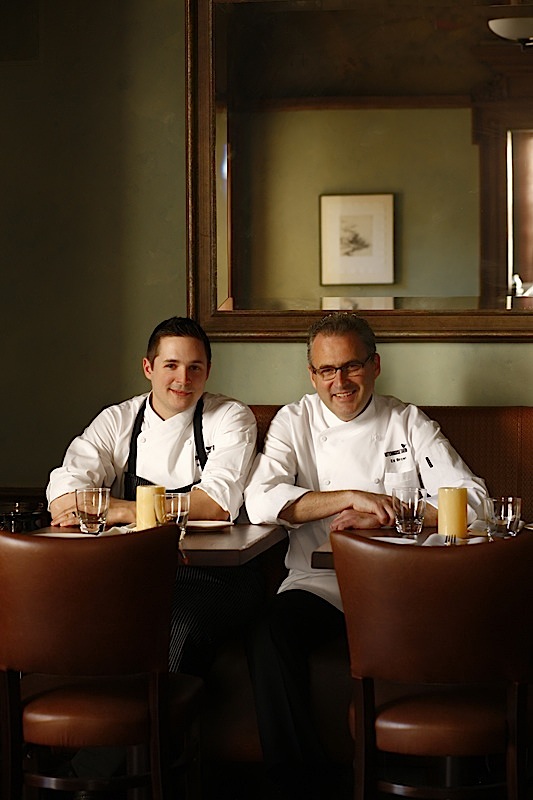 with Speck
oven-dried tomato, and arugula. Among
the appetizers, I liked best the roasted
sweetbread salad with tiny carrots, mustard seeds,
carrot butter, and sherry vinegar. An
ivory-colored wild mushroom soup was lovely to
look at, but didn't have much flavor, not helped
by a cocoa nib or mild walnut milk. Nor was there
much flavor in the polenta soup with ricotta.
with Speck
oven-dried tomato, and arugula. Among
the appetizers, I liked best the roasted
sweetbread salad with tiny carrots, mustard seeds,
carrot butter, and sherry vinegar. An
ivory-colored wild mushroom soup was lovely to
look at, but didn't have much flavor, not helped
by a cocoa nib or mild walnut milk. Nor was there
much flavor in the polenta soup with ricotta.
Saltiness plagued several of the dishes I tried,
which meant the more natural flavors were masked,
but I loved the scallops with a rhubarb reduction,
sweet white asparagus, and English peas, and wild
bass was nicely cooked, with chewy Tuscan kale,
mushrooms, and a hibiscus-red wine sauce. A rack
of Berkshire pork with crisp belly, purple
mustard, quinoa crust and endive was a splashy
dish but it didn't add up to all that much in
taste or texture.
There is a separate spot on the menu for “Sunday
fried chicken supper” at a remarkable $18 per
person, giving you half a chicken with buttermilk
biscuits and, the night I was there, marshmallow
sweet potatoes, a dish that need not be brought
back. The
fried chicken was good and juicy, as it should be
after being salt-brined for many hours and cooked
Sous-Vide, but frankly, I can't imagine going to
all that elaborate process when most fried chicken
cooks elsewhere would make a crispier, less salty
dish than this.
For dessert, I recommend the dark chocolate tart
with milk crumble, and caramelized milk ice cream.
The wine list is surprisingly short, only about 30
bottlings, when a place of this serious purpose
should have a serious list.
The restaurant
serves lunch, Tues.-Fri., dinner Tues.-Sun.;
Brunch, Sat. & Sun. Dinner appetizers
run $9-$16, main courses $19-$28.
❖❖❖
NEW
YORK CORNER
by John Mariani
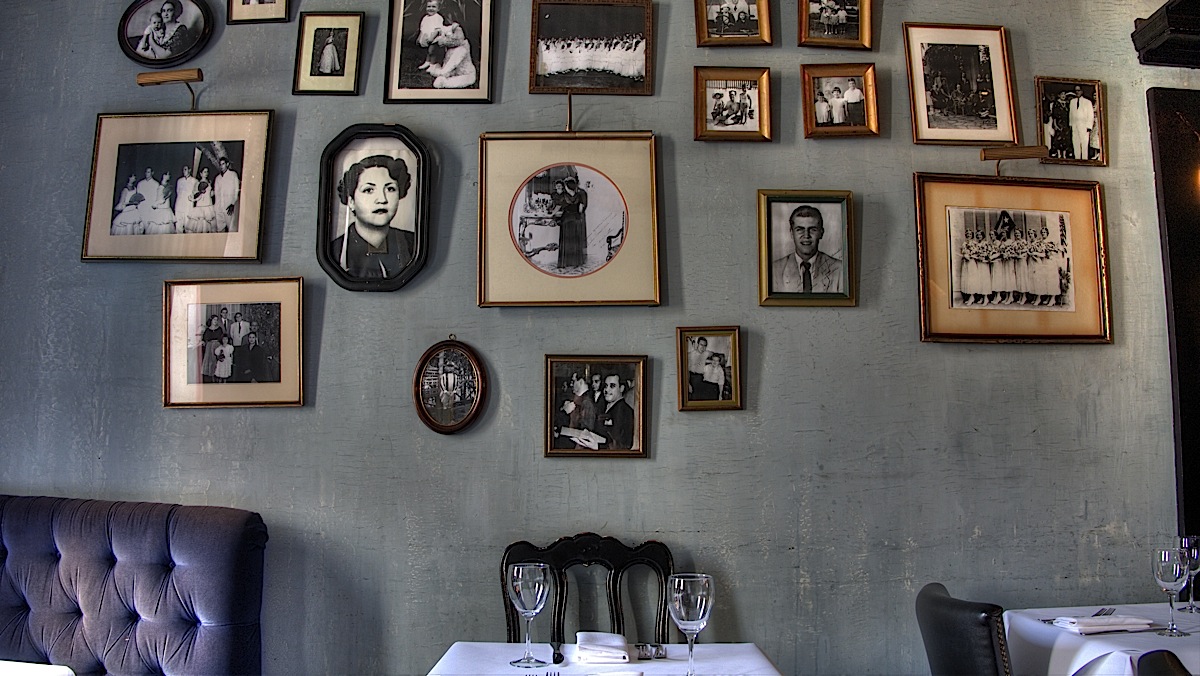 BOBO
BOBO181 West 10th Street (corner of 7th Avenue)
212-488-2626
Bobo.com
Charm
is not so easy to come by these days, when
cramped, loud, barebones lunch counters pass for
restaurants, so sitting down to dine at Bobo is as
restorative as it is delicious. Owner
Carlos Suarez (who also has the new Rosemary’s across
the road) was inspired to create at Bobo the “joy of
having friends over for dinner,” and arriving at the
top of the stairs at this Greenwich Village and
entering the small dining room you may well think that
us exactly the case.
Bobo looks like the dining room of a friend
with impeccable, highly personalized taste, with
family photos on the walls, crisp linens and napery on
the tables, an ornate turn-of-the-century fireplace
and mirror, tall windows with long curtains, and glass
beads hanging from the ceiling. The tufted banquettes
are just asking to be occupied all night long.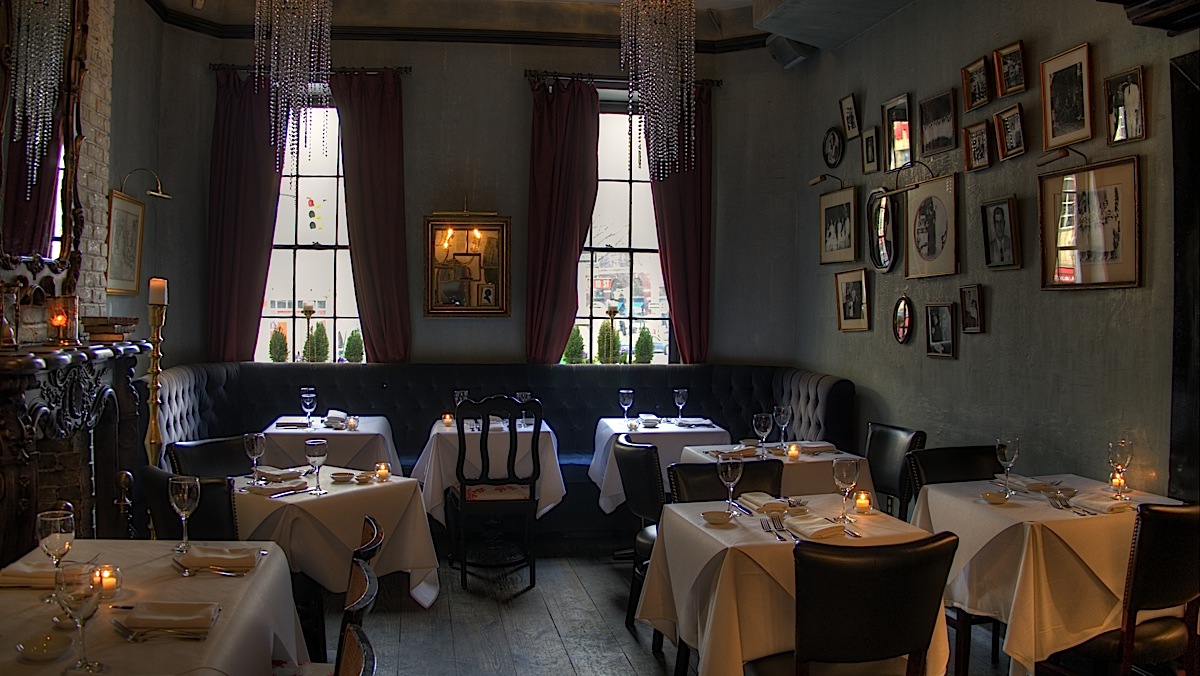
Add to this an extremely courteous waitstaff
and a serious commitment to well-made cocktails, and
you have the kind of place that one would like to
think Greenwich Village is full of, which is no longer
the case at all.
Suarez has brought aboard a fine, well-known
young chef, Cedric Tovar, formerly at Town and Peacock
Alley, and his cuisine is of a sort that he might well
serve at his home on Sunday afternoons, especially now
in autumn when flavors like butternut squash soup with
cardamom whipped cream, 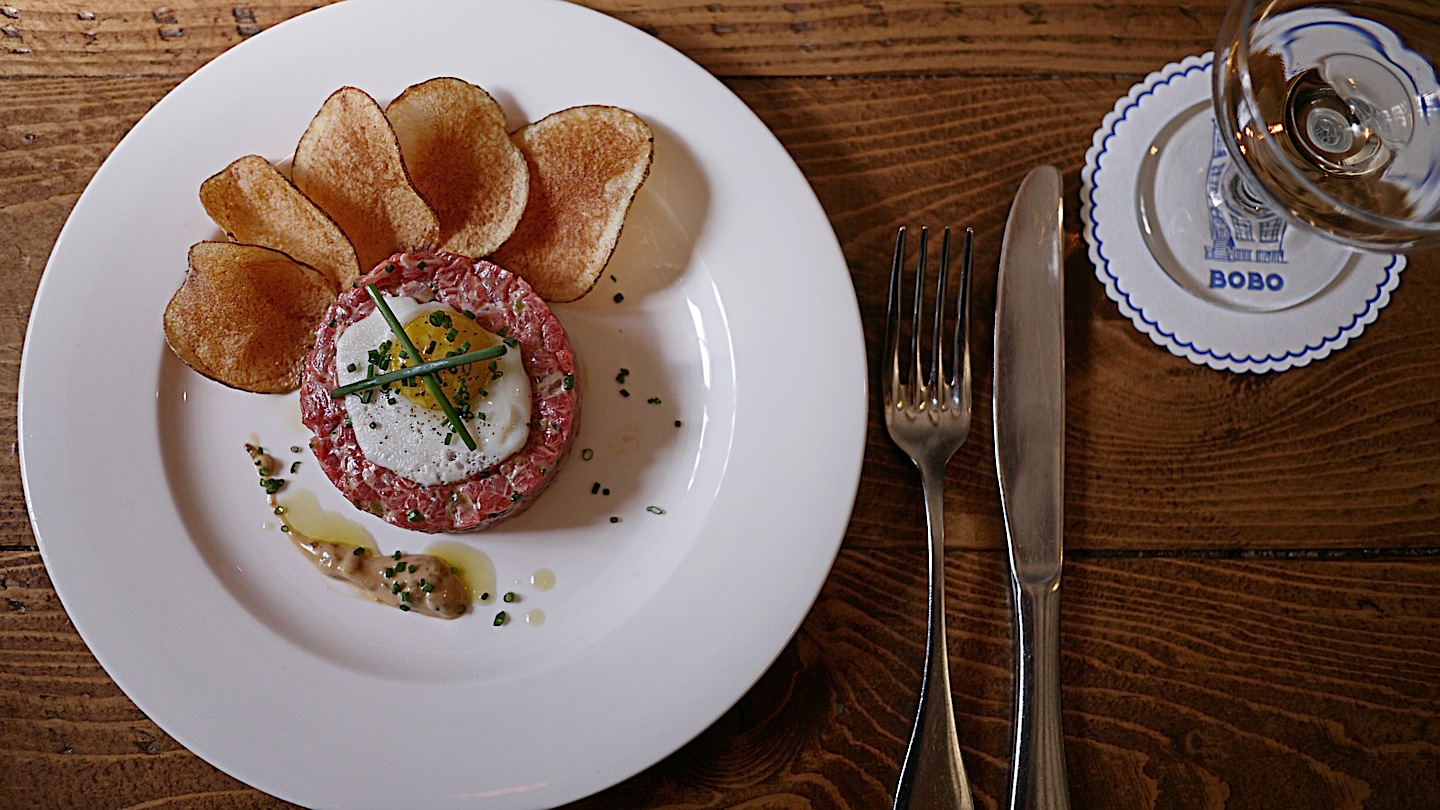 salted pumpkin
seed for crunch, and a sweet-sour huckleberry coulis
come into bloom.
salted pumpkin
seed for crunch, and a sweet-sour huckleberry coulis
come into bloom.
There are classics here like steak tartare
(below) with fresh potato chips, frisée salad
with crisp bacon lardons
and pork belly, topped with an oozy poached egg.
Ravioli is stuffed not with ricotta but with very rich
Comte cheese, adrift in a creamy mushroom broth and
dusted with Parmesan.
Main courses range from scallops that have been
crusted with pumpkin seeds, with braised spaghetti
squash, and a delightful ginger carrot sauce, to steak
au poivre very with French fries. I love
skate, and here it is à la grenobloise, with
parsley root, braised salsify, and preserved lemon
coulis. Tovar
poaches lobster in butter and thyme and teams it with
sauteed mushrooms, watercress veloute, and grilled
broccoli di rabe, while the big splurge on the menu is
a piece du boucher,
a 12 ounce, 28-day dry aged strip steak with bone
marrow, bordelaise sauce, and your choice of a side
dish like pommes
purée of pommes frites.
There's a fine
selection of cheeses I availed myself of--inckluding a
raw goat's milk from Sofia Farm in Greenville,
Indiana, and a Great Hill Blue from Marion,
Massachusetts. For dessert, how can you turn
down a Valrhona "Mars" chocolate mousse with
crunchy chocolate shell or Black Mission fig sable
with vanilla ice cream and fig jam?
Bobo is a place
with its warm personality out in front of its charming
ambiance, where every dish seems to complement the
intent to please you and make you feel a cherished
guest.
Bobo serves BRUNCH: SAT – SUN; DINNER NIGHTLY;
Appetizers run $12-$17, main courses $27-$48.
❖❖❖
NOTES FROM THE WINE CELLAR
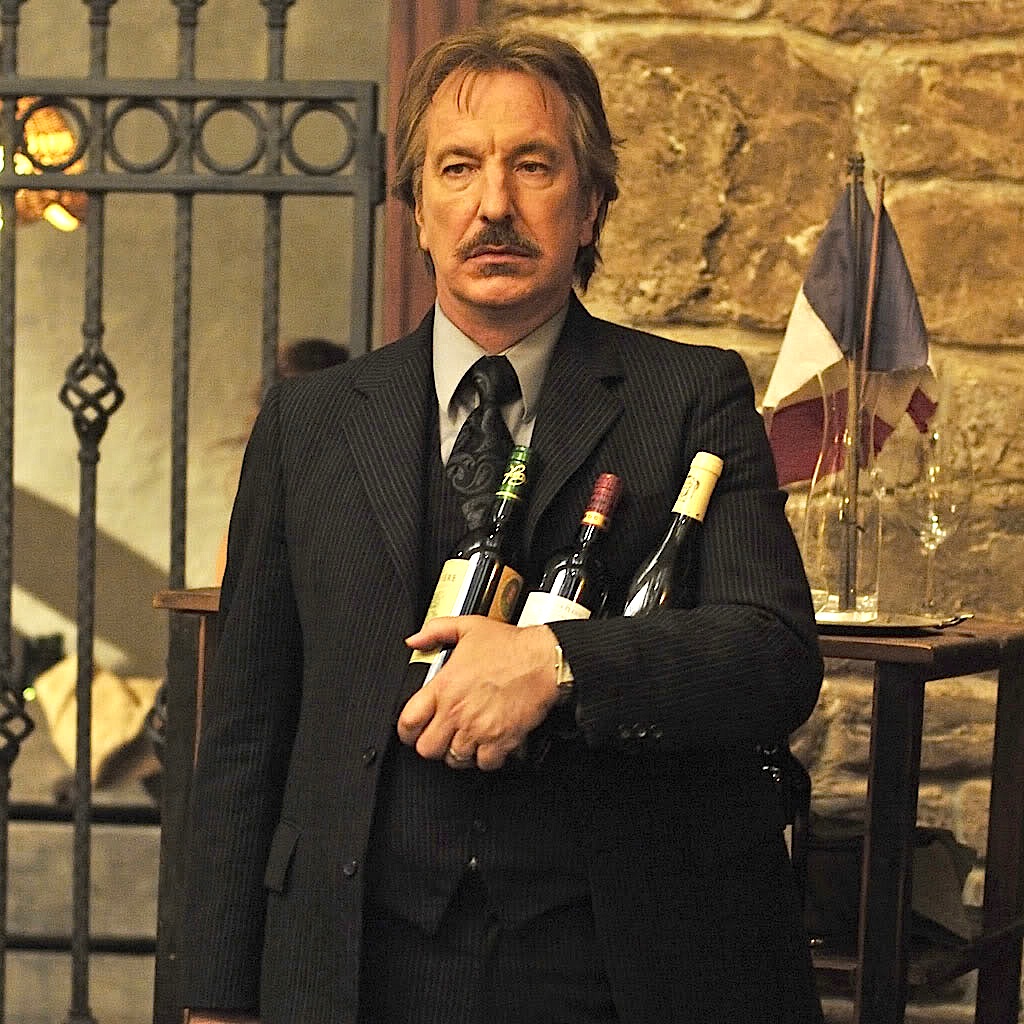 So You Wanna
Run a Wine Tasting?
So You Wanna
Run a Wine Tasting?
by
John Mariani
Such a slog is not only hard work but palate fatigue sets in early, so that the 46th wine you taste is never going to have quite the luster of the third, and by number 75, you are in agony and in need of a shower.
Still, the idea of holding your own wine tasting at home or in a restaurant can be one of the most convivial of pleasures, as long as you go about it the right way, starting with whom you invite.
Basically, there are three kinds of people who drink wine: those who kind of like it, those who truly love it, and those who regard it as a study in one-upmanhsip. Only the second type is any fun at a wine tasting, especially if you’re going to be serving some expensive wines that the first group will shrug at and the third will sniff and go into discourses about the wines’ Ph level and the vineyards’ trellising techniques. Once you’ve chosen your jolly group (please skip the black tie request!), there are certain guidelines that make such tastings a great deal of fun.
1.
Never serve more than six wines. Less is
hardly worth the effort and more becomes a bore.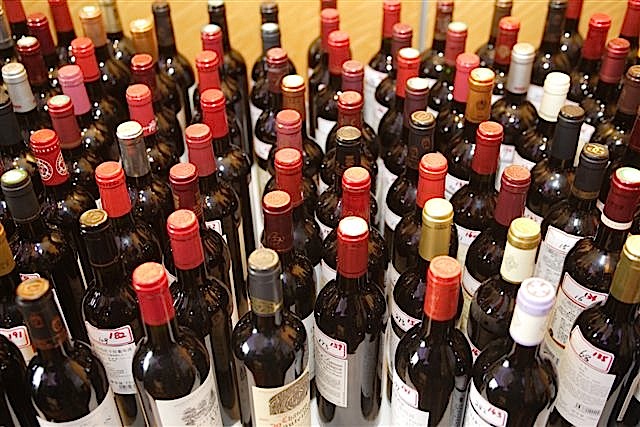
2.
Will it be a blind tasting? If so,
cover the bottles with a paper bag to hide the labels,
making sure the shape of the bottle is not evident.
(Pinot noirs and rieslings always come in
distinctively shaped bottles.) Number them and keep
the list out of sight.
3.
If
it’s not a blind tasting, rather than have a random
selection of wines, choose one region, say Tuscany, or
a single estate, say, Jordan cabernet. If the former,
a horizontal tasting of a single vintage will give
interesting insight into the differences of wines from
the same region; if the latter, have a vertical
tasting, that is, from different vintages of the same
wine.
4.
Use
standard wineglasses for all the wines and pour only
about an ounce or so to begin with. Later your guests
can enjoy whatever they like most.
5.
Have
plain water available to help clear the palate between
wines.
6. Crackers
or bread is customarily made available, also to clear
the palate, chosen because they are bland and do not
interfere with the wine flavors. But I believe it is
much better to serve crackers like Saltines or bread
like focaccia whose salt works as salt always does—to
perk up flavors. I’ve also found that a little fat,
along with the salt, brings out much more depth in
wines you taste, so put a sheer amount of salted
butter, or olive oil, on the bread. It works wonders.
7.
If
you are serving the wines with dinner—and I heartily
recommend you do so—keep the food very, very simple,
like mild cheese, chicken broth, a steak, or, if
you’re tasting white wines, fillet of fish.
8.
You might have guests taste all the
wines prior to dinner—remember, you’re only sampling
six—then match them with dinner. For the real point of
tasting wines is that they go best with food, and with
few exceptions, aren’t worth much without food, not
even a glass of Champagne without at least a canape.
9.
During
the discussion, try to keep the conversation lively
(remember, you didn't invite the wine snobs to lecture
anyone), and it’s a capital idea to have a few choice
observations from great writers handy for toasts like
these:
-“No nation
is drunken where wine is cheap.”—Thomas Jefferson.
--“Let us
have wine and women, mirth and laughter,/ Sermons and
soda-water the day after.”—Lord Byron.
--“Wine,
madam, is God’s next best gift to man.”—Ambrose
Bierce.
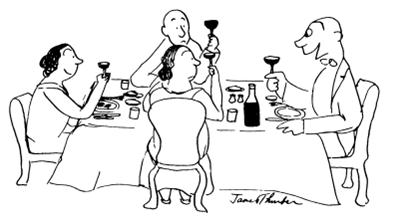 --“It’s a naïve domestic Burgundy
without any breeding, but I believe you’ll be amused
by its presumption.”—James Thurber (left)
--“It’s a naïve domestic Burgundy
without any breeding, but I believe you’ll be amused
by its presumption.”—James Thurber (left)
--“It was a
very Corsican wine and you could dilute it by half
with water and still receive its message.”—Ernest
Hemingway.
10. Print out the names of all the wines for
guests to take home.
11. Finish every drop of every wine you open.
❖❖❖
NEWS FROM
GREAT BRITAIN:
DIGNITY, ALWAYS DIGNITY
According to British newspapers, Chef Marco
Pierre White's ex-wife, Matilde Conejero, admitted
damaging his Range Rover saying
she broke the car's front and back windshields with
a child's scooter, then wrote insulting graffiti on
a wall with nail polish and some of her own blood,
causing £12,000 of damage. Judge Philip
Matthew adjourned sentencing, saying that
Conejero would not be facing a custodial sentence.
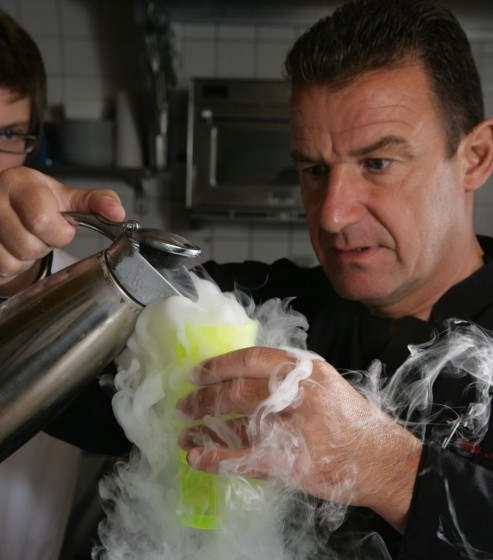 WELL, SO MUCH FOR
NORDIC AND
WELL, SO MUCH FOR
NORDIC AND
MOLECULAR CUISINE
A British teenager named Gaby Scanlon had her stomach surgically removed after drinking a cocktail made with liquid nitrogen at Oscar's Wine Bar in Lancaster after allegedly drinking a "Pornstar Martini," consisting of passion fruit, vanilla vodka, pineapple juice, Champagne, and Chanson, and liquid nitrogen, to create a smoky effect. . . . Meanwhile, in Miami, FL, a man collapsed and died after eating dozens of the live bugs like cockroaches and worms.
❖❖❖
Any of John Mariani's
books below may be ordered from amazon.com.
 |
My latest book, which just won the prize for best book from International Gourmand, written with Jim Heimann and Steven Heller, Menu Design in America, 1850-1985 (Taschen Books), has just appeared, with nearly 1,000 beautiful, historic, hilarious, sometimes shocking menus dating back to before the Civil War and going through the Gilded Age, the Jazz Age, the Depression, the nightclub era of the 1930s and 1940s, the Space Age era, and the age when menus were a form of advertising in innovative explosions of color and modern design. The book is a chronicle of changing tastes and mores and says as much about America as about its food and drink.
“Luxuriating vicariously in the pleasures of this book. . . you can’t help but become hungry. . .for the food of course, but also for something more: the bygone days of our country’s splendidly rich and complex past. Epicureans of both good food and artful design will do well to make it their coffee table’s main course.”—Chip Kidd, Wall Street Journal.
“[The menus] reflect the amazing craftsmanship that many restaurants applied to their bills of fare, and suggest that today’s restaurateurs could learn a lot from their predecessors.”—Rebecca Marx, The Village Voice. |
"Eating Italian will never be the same after reading John Mariani's entertaining and savory gastronomical history of the cuisine of Italy and how it won over appetites worldwide. . . . This book is such a tasteful narrative that it will literally make you hungry for Italian food and arouse your appetite for gastronomical history."--Don Oldenburg, USA Today. "Italian
restaurants--some good, some glitzy--far
outnumber their French rivals. Many of
these establishments are zestfully described
in How Italian Food Conquered the World, an
entertaining and fact-filled chronicle by
food-and-wine correspondent John F.
Mariani."--Aram Bakshian Jr., Wall Street
Journal.
"Equal parts
history, sociology, gastronomy, and just
plain fun, How Italian Food Conquered the
World tells the captivating and delicious
story of the (let's face it) everybody's
favorite cuisine with clarity, verve and
more than one surprise."--Colman Andrews,
editorial director of The Daily
Meal.com. "A fantastic and fascinating
read, covering everything from the influence
of Venice's spice trade to the impact of
Italian immigrants in America and the
evolution of alta cucina. This book will
serve as a terrific resource to anyone
interested in the real story of Italian
food."--Mary Ann Esposito, host of PBS-TV's
Ciao
Italia. "John Mariani has written the
definitive history of how Italians won their
way into our hearts, minds, and
stomachs. It's a story of pleasure over
pomp and taste over technique."--Danny Meyer,
owner of NYC restaurants Union Square Cafe,
Gotham Bar & Grill, The Modern, and
Maialino.
|
 |
 |
 |
 |
 |
 |
 |
 |
 Everett Potter's Travel Report:
Everett Potter's Travel Report: 
 Eating Las Vegas
is the new on-line site for Virtual Gourmet
contributor John A. Curtas., who since 1995
has been commenting on the Las Vegas food
scene and reviewing restaurants for Nevada
Public Radio. He is also the
restaurant critic for KLAS TV, Channel 8 in
Las Vegas, and his past reviews can be
accessed at KNPR.org.
Click on the logo below to go directly to
his site.
Eating Las Vegas
is the new on-line site for Virtual Gourmet
contributor John A. Curtas., who since 1995
has been commenting on the Las Vegas food
scene and reviewing restaurants for Nevada
Public Radio. He is also the
restaurant critic for KLAS TV, Channel 8 in
Las Vegas, and his past reviews can be
accessed at KNPR.org.
Click on the logo below to go directly to
his site.

Tennis Resorts Online: A Critical Guide to the World's Best Tennis Resorts and Tennis Camps, published by ROGER COX, who has spent more than two decades writing about tennis travel, including a 17-year stretch for Tennis magazine. He has also written for Arthur Frommer's Budget Travel, New York Magazine, Travel & Leisure, Esquire, Money, USTA Magazine, Men's Journal, and The Robb Report. He has authored two books-The World's Best Tennis Vacations (Stephen Greene Press/Viking Penguin, 1990) and The Best Places to Stay in the Rockies (Houghton Mifflin, 1992 & 1994), and the Melbourne (Australia) chapter to the Wall Street Journal Business Guide to Cities of the Pacific Rim (Fodor's Travel Guides, 1991).


MARIANI'S VIRTUAL GOURMET
NEWSLETTER is published weekly. Editor/Publisher: John
Mariani.
Contributing Writers: Christopher Mariani, Robert Mariani,
John A. Curtas, Edward Brivio, Mort Hochstein,
Suzanne Wright, and Brian Freedman. Contributing
Photographers: Galina Stepanoff-Dargery,
Bobby Pirillo. Technical Advisor: Gerry McLoughlin.
© copyright John Mariani 2012
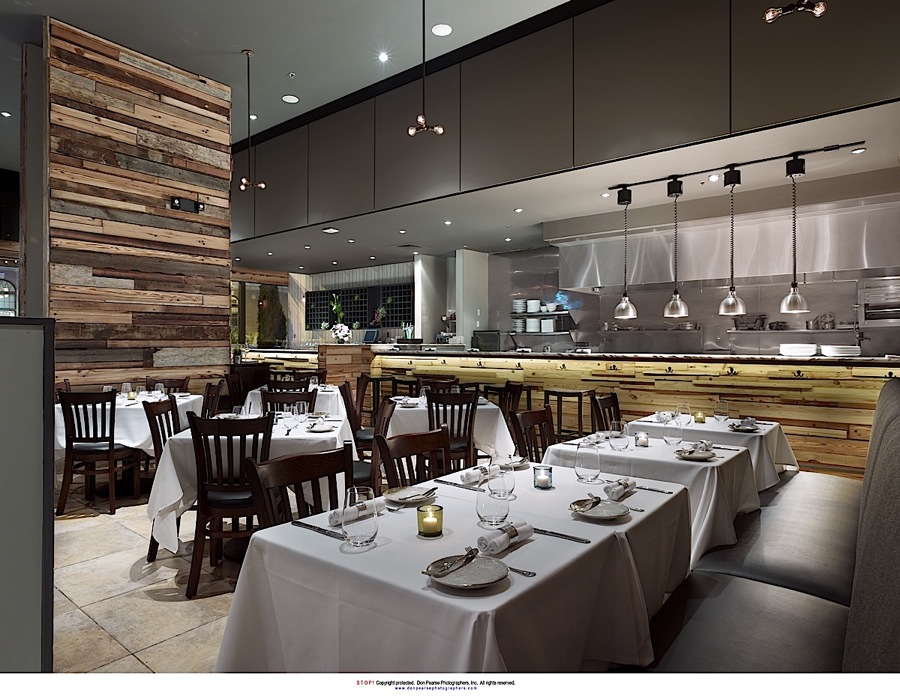 SBRAGA
SBRAGA